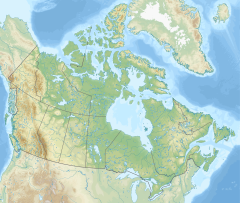Tetsa River
Appearance
| Tetsa River | |
|---|---|
| Location | |
| Country | Canada |
| Provins | British Columbia |
Tetsa River is a river in northeastern British Columbia, Canada. It heads into the Northern Rocky Mountains Provincial Park, and flows northeast and then east into the Muskwa River. In the area around Tetsa River there are mainly pine forests. The area around Tetsa River is almost uninhabited, with less than two inhabitants per square kilometre. Highway 97 / Alaska Highway runs through this place.
The neighbourhood is part of the boreal climate zone. The annual average temperature is -0.8 °C. The warmest month is July, with an average temperature of 13.5 °C, and the coldest is January, -15.9 °C.[1]
Climate
[edit]| Climate data for Tetsa River | |||||||||||||
|---|---|---|---|---|---|---|---|---|---|---|---|---|---|
| Month | Jan | Feb | Mar | Apr | May | Jun | Jul | Aug | Sep | Oct | Nov | Dec | Year |
| Record high °C (°F) | 16.0 (60.8) |
14.5 (58.1) |
15.0 (59.0) |
22.0 (71.6) |
28.0 (82.4) |
29.0 (84.2) |
31.0 (87.8) |
30.5 (86.9) |
25.5 (77.9) |
26.0 (78.8) |
14.5 (58.1) |
18.0 (64.4) |
31.0 (87.8) |
| Mean daily maximum °C (°F) | −10.9 (12.4) |
−6.7 (19.9) |
−1.0 (30.2) |
7.2 (45.0) |
12.9 (55.2) |
17.7 (63.9) |
19.4 (66.9) |
18.3 (64.9) |
12.7 (54.9) |
5.3 (41.5) |
−6.6 (20.1) |
−8.5 (16.7) |
5.0 (41.0) |
| Daily mean °C (°F) | −15.9 (3.4) |
−12.9 (8.8) |
−7.8 (18.0) |
0.8 (33.4) |
6.6 (43.9) |
11.5 (52.7) |
13.5 (56.3) |
12.1 (53.8) |
6.8 (44.2) |
0.0 (32.0) |
−11.3 (11.7) |
−13.3 (8.1) |
−0.8 (30.6) |
| Mean daily minimum °C (°F) | −20.8 (−5.4) |
−19.1 (−2.4) |
−14.5 (5.9) |
−5.6 (21.9) |
0.3 (32.5) |
5.3 (41.5) |
7.6 (45.7) |
5.8 (42.4) |
1.0 (33.8) |
−5.3 (22.5) |
−15.9 (3.4) |
−18.1 (−0.6) |
−6.6 (20.1) |
| Record low °C (°F) | −41.0 (−41.8) |
−41.0 (−41.8) |
−37.0 (−34.6) |
−28.0 (−18.4) |
−16.5 (2.3) |
−2.0 (28.4) |
0.0 (32.0) |
−6.0 (21.2) |
−11.0 (12.2) |
−30.0 (−22.0) |
−45.0 (−49.0) |
−39.0 (−38.2) |
−45.0 (−49.0) |
| Average precipitation mm (inches) | 24.9 (0.98) |
21.2 (0.83) |
29.9 (1.18) |
30.7 (1.21) |
82.0 (3.23) |
116.0 (4.57) |
150.7 (5.93) |
106.9 (4.21) |
61.0 (2.40) |
40.3 (1.59) |
26.1 (1.03) |
17.9 (0.70) |
707.7 (27.86) |
| Average rainfall mm (inches) | 0.1 (0.00) |
0.0 (0.0) |
0.0 (0.0) |
4.3 (0.17) |
60.9 (2.40) |
115.5 (4.55) |
150.7 (5.93) |
104.9 (4.13) |
51.7 (2.04) |
4.8 (0.19) |
0.0 (0.0) |
0.0 (0.0) |
493.0 (19.41) |
| Average snowfall cm (inches) | 24.9 (9.8) |
21.2 (8.3) |
29.9 (11.8) |
26.3 (10.4) |
21.0 (8.3) |
0.5 (0.2) |
0.0 (0.0) |
2.0 (0.8) |
9.3 (3.7) |
35.5 (14.0) |
26.1 (10.3) |
17.9 (7.0) |
214.7 (84.5) |
| Average precipitation days | 7.3 | 6.6 | 7.1 | 6.8 | 13.1 | 16 | 19.6 | 14.6 | 11.7 | 8.0 | 7.7 | 5.8 | 124.2 |
| Average rainy days | 0.04 | 0 | 0 | 1.5 | 10.8 | 16.0 | 19.6 | 14.4 | 10.3 | 2.2 | 0.04 | 0 | 74.9 |
| Average snowy days | 7.2 | 6.6 | 7.1 | 5.7 | 3.4 | 0.14 | 0 | 0.36 | 2.0 | 6.4 | 7.7 | 5.8 | 52.3 |
| Source: Environment Canada[1] | |||||||||||||
See also
[edit]References
[edit]- ^ a b "1981–2010 Climate Normals". Environment and Climate Change Canada. Retrieved 2018-07-24.
- ^ "NASA Earth Observations: Population Density". NASA/SEDAC. Retrieved 30 January 2016.
- ^ Peel, M C; Finlayson, B L; McMahon, T A (2007). "Updated world map of the Köppen-Geiger climate classification". Hydrology and Earth System Sciences. 11: 1633–1644. doi:10.5194/hess-11-1633-2007. Retrieved 2016-01-30.
- ^ "NASA Earth Observations Data Set Index". NASA. Retrieved 30 January 2016.
- ^ "NASA Earth Observations: Land Cover Classification". NASA/MODIS. Retrieved 30 January 2016.

